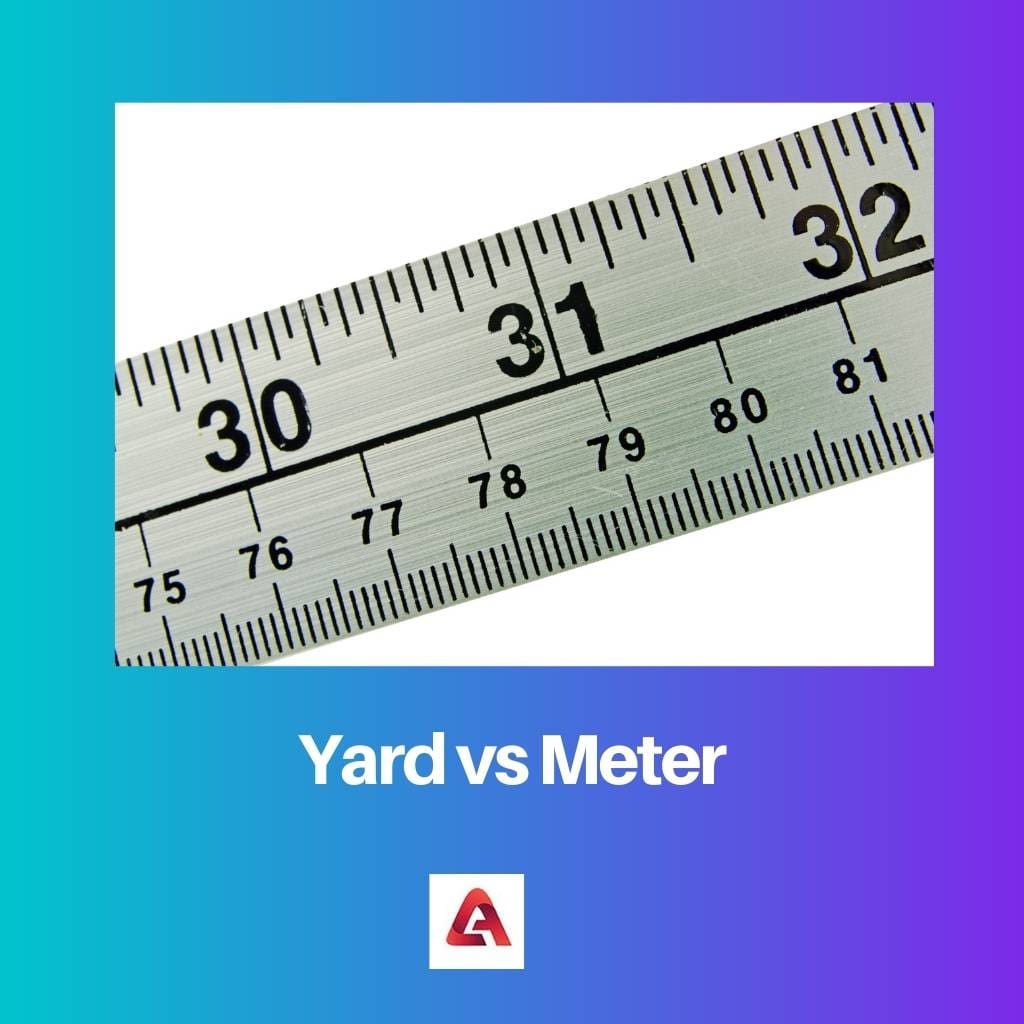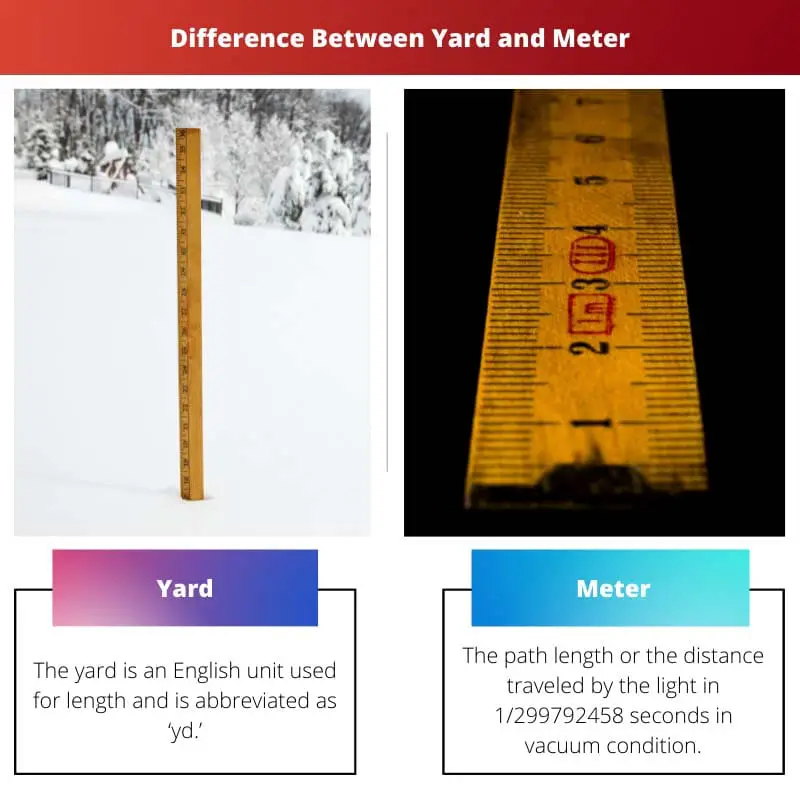Measurement of different kinds of things is done by different terms and units. Even for one same parameter, we have different units, each of them having a different value or being in a different metric system.
The seven fundamental units for different physical quantities are kilogram (mass), meter (length), Kelvin (temperature), Ampere (electric current), second (time), Candela (luminous intensity), and mole (amount of substance). This is about the SI system, while the CGS system has different units for the same parameters.
Key Takeaways
- A yard is an imperial unit of length equal to 3 feet or 36 inches, while a meter is a metric unit equal to approximately 39.37 inches.
- One yard equals 0.9144 meters, and one meter equals 1.0936 yards.
- Meters are more widely used globally due to the adoption of the metric system, while yards are predominantly used in the United States and the United Kingdom.
Yard vs Meter
A yard is a unit of length commonly used in the United States and the United Kingdom and is equal to 3 feet or 36 inches, or approximately 0.9144 meters. A meter is the fundamental unit of length in the International System of Units (SI) and is approximately equal to 39.37 inches or 1.0936 yards.

The yard is the unit applicable in the United States and the United Kingdom, along with other American countries, for the measurement of length. It is not used globally as the unit for length.
A Meter is the standard unit for the measurement of length. It is used globally and is the fundamental unit in the International Unit of Systems for length. One meter equals 100 centimetres, and 1000 meters equals one kilometre. The symbol used to denote the meter is ‘m’.
Comparison Table
| Parameters of Comparison | Yard | Meter |
|---|---|---|
| Definition | The yard is an English unit used for length and is abbreviated as ‘yd.’ | The path length or the distance traveled by the light in 1/299792458 seconds in vacuum condition. |
| Symbol | yd | m |
| Histology | The English word ‘gerd’ or ‘gyrd’ was used for twigs, measuring rods, and branches. | Meter– derived from Greek word which means ‘to measure,’ and from French unit mètre. |
| Unit | US Customary system and British Imperial | International Standard Unit |
| Value equivalent | 0.9144 meter; 91.44 cm (centimeter) | 1.094 yards; 100 cm (centimeter) |
| Usage | Measurement of ground length such as cricket pitch, golf court, etc. | Meter is the standard unit used for all kinds of measurements of length. |
What is Yard?
A yard is an English unit used for length. It is abbreviated as ‘yd.’ The term yard is derived from the English word ‘gerd’ or ‘gyrd,’ which was originally used for twigs, measuring rods, and branches.
A physical standard was used to prepare a metal yardstick used for measurement. This metal yardstick was originally designed for the derivation of other measurements of length for the English system of measurements.
So, finally, in 1959, the United Kingdom, the United States, South Africa, New Zealand, and Australia switched to the Canadian measurement system that comprised values where one yard was equal to 0.9144 meters. The yard system of measurement is still used for the measurement of fields in some countries such as America and, in cases of the Canadian Football Association, cricket field dimensions and in case of golf court dimensions.

What is Meter?
The meter has two spellings: meter (American spelling, derived from a Greek word which means ‘to measure,’ and from the French unit mètre) and meter (International Bureau of Weights and Measures or Bureau International des Poids et Mesures spelling, and British spelling). A meter is used globally and is the international standard unit of length.
The meter in the SI unit system is demoted as ‘m’. Definition of the length according to the SI system: The path length or the distance travelled by the light in 1/299792458 seconds in vacuum conditions.
The current definition in use was adopted 23 years later, in 1983. A unit of an imperial inch equals 0.0254 meters, 25.4 millimetres, or 2.54 centimetres.

Main Differences Between Yard and Meter
- The yard is a measurement of length that was predominantly used in the United States and the United Kingdom. A meter is a unit of length that was predominantly used in Canadian countries but is now the International Standard for length all over the globe.
- The yard is obsolete and is used in the measurement of ground length, such as cricket pitch, golf court, etc. The meter is the standard unit used for all kinds of measurements of length.
- One yard equals 0.9144 meters, while one meter equals 1.094 yards.
- In terms of the CGS unit, one yard equals 91.44 cm (centimetre), while a meter equals 100 cm (centimetre).
- Originally, a yardstick was used for measurement in terms of yards. For measurement in terms of meters, a scale or measuring tape is used in general daily life.

- https://journals.aps.org/pri/abstract/10.1103/PhysRevSeriesI.1.19
- https://eric.ed.gov/?id=ED414182
- https://books.google.co.in/books?hl=en&lr=&id=eHd_A2sYNfQC&oi=fnd&pg=PR3&dq=yard+and+meter&ots=2VzMgJj6FP&sig=evc0TTFZvBgSHlrujp3nToIFXdM&redir_esc=y#v=onepage&q=yard%20and%20meter&f=false

The distinction between the yard and the meter units is clearly articulated with historical and technical references in this post.
Absolutely, the detailed explanation serves as an effective educational resource for understanding these measurements.
This post has effectively highlighted the distinction between the yard and the meter units of measurement.
Definitely, it’s very enlightening to learn about the historical origins and usage of these measurement units.
The comparison table provided is excellent and serves as a useful reference for understanding the differences between yards and meters.
Indeed, the historical and technical aspects of the yard and meter measurements are clearly explained.
I agree, the detailed comparison table allows for easy understanding of the distinctions between the two units.
The detailed description of the yard and meter units in this post is quite enlightening and well-organized.
Absolutely, the comparison provided is very informative and contributes to a better understanding of these units.
I couldn’t agree more, the detailed insight into the historical and technical aspects of these units is exceptional.
The post offers a well-structured comparison between the historical and technical aspects of yard and meter measurements, very enlightening.
Definitely, the comprehensive overview allows for a clear understanding of the differences and uses of yard and meter units.
The historical details and definitions of the yard and meter measurements are excellently presented in this post.
Indeed, the detailed information adds a valuable perspective on the use and significance of these units.
This post provides a comprehensive explanation of the historical and global usage of the yard and the meter, very informative!
Absolutely, an insightful post that covers the essential aspects of each measurement unit.
The explanation about the differences between the yard and the meter is very detailed and informative
Absolutely, the information shared provides a clear understanding of the two units and their history.
Yes, a comprehensive explanation of the units’ measurement and their usage, great post!
The in-depth explanation about the historical background and usage of the yard and meter units is quite enlightening and well-presented.
I couldn’t agree more, the post effectively provides a thorough understanding of the yard and meter measurements.
Absolutely, the historical context and detailed descriptions contribute to a comprehensive insight into these measurement units.
The explanation provided about the yard and meter units, along with the comparison table, is highly informative and well-structured.
Indeed, the comparison table provides a succinct overview, making it easier to comprehend the differences between the two units.
Absolutely, the post effectively covers the technical and historical aspects of both measurement units.